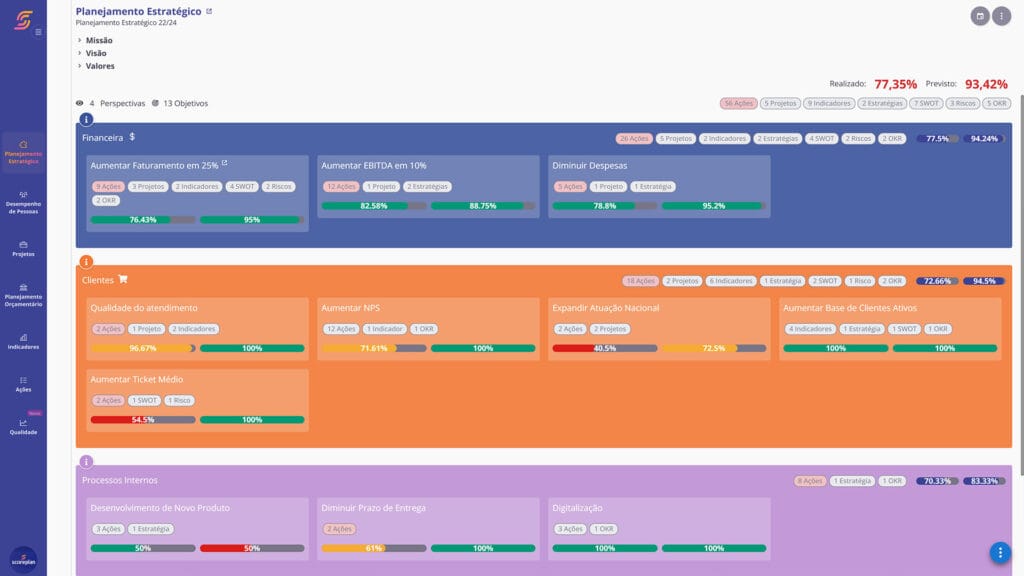There are different types of organizational structure, but which model suits your business the best?
Today, we’ll help answer that question. In this article, we list six types of organizational structure and explain how you can determine which one aligns with your company’s needs. We also provide a step-by-step guide to help you understand what to consider when making this decision.
Check it out!
What is an organizational structure?
An organizational structure defines how a company organizes its employees and departments, outlining roles, responsibilities, and hierarchical levels. It establishes the relationships between leaders and teams and provides a clear view of how human and material resources are distributed. This structure directs the company toward achieving strategic goals, maximizing employee performance, and ensuring every department has clear leadership to guide its activities and responsibilities.
What are the types of organizational structure and their characteristics?
1) Functional structure
A functional structure divides the organization based on specific areas of expertise, such as marketing, finance, sales, or HR. Each department has a clear specialization, which enhances daily activities.
Benefits:
- Communication issues between departments due to siloed teams.
- Challenges with interdepartmental projects due to rigid division.
2) Matrix structure
The matrix structure combines elements of a functional structure with a project-based approach. Employees have both functional and project-specific responsibilities.
For instance, a marketing team member may also be part of a strategic planning project.Advantages:
- Ambiguity about project authority.
- Communication missteps.
- Potential conflicts between departments.
3) Divisional structure
The divisional structure organizes the company based on products, markets, or geographic regions. Each division operates almost autonomously with its own marketing, finance, and other departments. This model suits large companies offering diverse products or operating in different locations.Advantages:
- Higher resource demands to cover all divisions.
- Difficulty in cross-department communication.
4) Linear structure
A linear structure follows a strict hierarchy where each employee reports to an immediate superior. It is suitable for small companies or organizations with fewer complex activities due to its direct communication flow and quick decision-making process.
Advantages:
- Less collaboration across the organization.
- Increased bureaucracy for implementing changes.
- Overload on leaders.
5) Network Structure
The network structure is modern and flexible, focusing on partnerships and outsourcing. The company retains its strategic core while outsourcing secondary activities to partners or other organizations.
Advantages:
- Heavy reliance on third parties.
- Possible communication difficulties with partners.
- Less operational control.
6) Line and staff structure
This structure combines a traditional linear command chain with specialized support (staff). It incorporates technical, administrative, or advisory teams to assist decision-making processes.
Advantages:
- Authority issues.
- Conflicts between operational teams and specialists.
- Increased hierarchy complexity as the company grows.
What is the importance of an organizational structure for a company?
An organizational structure is essential for businesses because it establishes the foundation for all internal operations. It defines the roles of each employee and the authority within the organization. Therefore, managers must seek the best type of organizational structure for their business.
With a clear structure in place, companies can optimize the use of their human and material resources, leading to better team performance. Additionally, a well-designed organizational structure reduces conflicts caused by poor team organization.
Another crucial aspect of an organizational structure is its role in supporting healthy business growth. Like a building requires a strong foundation, a company needs a solid structure to expand, closely tied to how its management is developed.
How to choose the right type of organizational structure for your company?
After understanding the 6 types of organizational structure and their importance to businesses, it’s crucial to know how to choose the right one for your organization. Follow this step-by-step guide to identify the ideal structure for your business.
Step 1: Evaluate your company’s size
Is your company micro, small, medium, or large? This is the first question to answer when selecting the right organizational structure.
For smaller businesses, simpler structures, like linear ones, work well since they have fewer hierarchical layers and encourage direct communication. Larger companies with diverse areas and functions benefit from functional or divisional structures.
Larger structures allow companies to divide their operations into specialized departments, making it easier to manage complex activities.
Step 2: Analyze operational complexity
Companies dealing with diverse operations—such as multiple products, markets, or geographic regions—can choose between divisional or matrix structures. The divisional structure enables each unit (product, market, or region) to operate almost independently, while the matrix structure fosters departmental integration, ideal for interdepartmental projects requiring collaboration across various areas of expertise.
Step 3: Consider your culture and strategic goals
What’s your company culture like? Are your employees well-integrated and engaged in the management process?
If your business culture emphasizes innovation and agility, a flexible structure, like the network model, may be ideal as it supports partnerships and outsourcing.
On the other hand, if your company prioritizes centralized control and clearer responsibilities, more rigid structures like functional or linear ones are better suited.
Strategic goals also play a role in this decision—companies aiming for rapid expansion may require flexible structures, while well-established businesses may not.
Step 4: Determine the level of control desired
Do you prefer centralized control or decentralized management?
If you need tighter control and direct supervision, a functional structure is a strong choice as it offers specialized oversight within each department.
For companies valuing team autonomy and cross-departmental collaboration, matrix or network structures are better, as they encourage dynamic teamwork across different areas.
Step 5: Assess collaboration needs
Businesses requiring high collaboration across departments should consider a matrix structure, where teams from various areas work together on specific projects. This structure enhances communication and cooperation, making it ideal for companies managing complex products or services requiring input from multiple sectors.
Step 6: Review your available resources
Finally, assess your financial and human resources to ensure the selected structure is viable. Complex structures, like matrix or divisional models, demand more resources, including personnel and technology.
Companies with limited resources can adopt leaner structures, like the linear model, until they grow and transition to more complex systems. Evaluating your capacity to manage a larger structure helps avoid overburdening and ensures organizational stability.
Now that you know how to choose the best type of organizational structure for your business, it’s time to integrate this discussion into your strategic planning. With Scoreplan, you can centralize your planning efforts in one place and access them from anywhere online.



